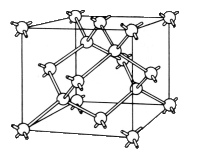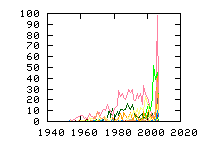« Previous
1
Next »
(16 hits, 1/1)
Showing
10, 25, 50, 100, 500, 1000, all papers per page.
Sort by:
last publication date,
older publication date,
last update date.
- 1. J.Am.Chem.Soc. 130, 48 (2008) , ACS , “Enhanced Ferromagnetism and Tunable Saturation Magnetization of Mn/C Codoped GaN Nanostructures Synthesized by Carbothermal Nitridation”, Zeyan Wang, Baibiao Huang, Lin Yu, Ying Dai, Peng Wang, Xiaoyan Qin, Xiaoyang Zhang, Jiyong Wei, Jie Zhan, Xiangyang Jing, Haixia Liu, and Myung-Hwan WhangboMn/C-codoped GaN nanostructures were synthesized by carbothermal nitridation with active charcoal as the carbon source. Nanostructures such as zigzag nanowires and nanoscrews were observed by varying the reaction time and the C/Ga molar ratio of the starting material used for the synthesis. The structures and morphologies of the as-grown samples were characterized by X-ray diffraction, scanning electron microscopy, and high-resolution transmission electron microscopy measurements. The doping of both Mn and C in the GaN matrix was confirmed by X-ray photoelectron spectroscopy measurements, and the ferromagnetic properties of Mn/C-codoped GaN samples were confirmed by room-temperature magnetization measurements. The saturation magnetization of Mn/C-codoped GaN increases steadily with increasing C/Ga molar ratio of the starting material at a rate of ~0.023 emu/g per C/Ga molar ratio, and the ferromagnetism of Mn/C-codoped GaN can be stronger than that of Mn-doped GaN by a factor of ~40. A plausible growth mechanism was proposed, and the role of carbon codoping in tuning the morphology and ferromagnetic property was discussed. Our work suggests that carbon doping in the GaN matrix favors the N sites over the Ga sites, Mn/C-codoping in the GaN matrix is energetically favorable, and the C-codoping strongly enhances the preference of the FM coupling to the AFM coupling between the two doped Mn sites. These suggestions were probed on the basis of first-principles density functional theory electronic structure calculations for a number of model doped structures constructed with a 32-atom 2 × 2 × 2 supercell. (Read more)
- 2. Appl. Phys. Lett. 89, 152910 (2006) , “Characterization of atomic-layer-deposited Al2O3/GaAs interface improved by NH3 plasma pretreatment”, Hong-Liang Lu, Liang Sun, Shi-Jin Ding, Min Xu, David Wei Zhang, and Li-Kang WangAl2O3 thin films were deposited by atomic layer deposition on HF-cleaned and NH3 plasma-treated GaAs surfaces, respectively. The precursors used for Al2O3 films are trimethylaluminum and water. Effects of NH3 plasma pretreatment on... (Read more)
- 3. Appl. Phys. Lett. 89, 122112 (2006) , “Interface states for HfO2/Si structure observed by x-ray photoelectron spectroscopy measurements under bias”, Osamu Maida, Ken-ichi Fukayama, Masao Takahashi, Hikaru Kobayashi, Young-Bae Kim, Hyun-Chul Kim, and Duck-Kyun ChoiA 1.0 nm silicon nitride (SiN) layer can prevent reaction between HfO2 and Si completely. In this case, the interface state spectra obtained from x-ray photoelectron spectroscopy measurements under bias have two peaks above and below the midgap, attributable to Si dangling bonds... (Read more)
- 4. Appl. Phys. Lett. 89, 063503 (2006) , “Degradation mechanism of organic light-emitting device investigated by scanning photoelectron microscopy coupled with peel-off technique”, H. J. Shin, M. C. Jung, J. Chung, K. Kim, J. C. Lee, and S. P. LeeThe authors present space-resolved spectroscopic data on organic layers of a degraded organic light-emitting device. The data were obtained using a scanning photoelectron microscope (SPEM) coupled with peel-off technique to directly probe the uncontaminated organic layers, which were covered with... (Read more)
- 5. Appl. Phys. Lett. 89, 041918 (2006) , “Detection and mobility of hafnium in SiO2”, Dmitri O. Klenov, Thomas E. Mates, and Susanne StemmerHigh-angle annular dark-field imaging in scanning transmission electron microscopy and x-ray photoelectron spectroscopy were used to investigate thermal SiO2 layers doped with Hf by ion implantation. Hf was mobile under the focused electron beam in the as-implanted samples. After... (Read more)
- 6. Appl. Phys. Lett. 88, 193502 (2006) , “Role of oxygen vacancy in HfO2/SiHfO2/Si(100) interfaces”, D.-Y. Cho, S.-J. Oh, Y. J. Chang, T. W. Noh, R. Jung, J.-C. LeeWe have investigated the interface states in HfO2/SiO2/Si(100) systems that were prepared by using the in situ pulsed laser deposition technique. X-ray photoelectron spectroscopy data revealed that when the HfO2 film thickness exceeds 11 Å, the film... (Read more)
- 7. Appl. Phys. Lett. 88, 182903 (2006) , “Effects of Al addition on the native defects in hafnia”, Q. Li, K. M. Koo, W. M. Lau, P. F. Lee, J. Y. Dai, Z. F. Hou, X. G. GongTwo occupied native defect bands are experimentally detected in pure HfO2. The density of states of band one in the middle of the band gap reduces drastically with the Al addition, while that of band two slightly above the valence-band maximum remains rather unaffected. We attribute the... (Read more)
- 8. J. Appl. Phys. 100, 064501 (2006) , “Introduction of defects into HfO2 gate dielectrics by metal-gate deposition studied using x-ray photoelectron spectroscopy and positron annihilation”, A. Uedono, T. Naito, T. Otsuka, K. Shiraishi, K. Yamabe, S. Miyazaki, H. Watanabe, N. Umezawa, T. Chikyow, Y. Akasaka, S. Kamiyama, Y. Nara, and K. YamadaThe impact of TiN deposition on thin HfO2 films formed on Si substrates was studied using x-ray photoelectron spectroscopy and a monoenergetic positron beam. For the predeposition sample, the positrons implanted into Si were found to diffuse toward the HfO2/Si interface under... (Read more)
- 9. J. Appl. Phys. 99, 113520 (2006) , “Effects of hydrogen bond redistribution on photoluminescence of a-SiC:H films under thermal treatment”, A. V. Vasin, S. P. Kolesnik, A. A. Konchits, V. I. Kushnirenko, V. S. Lysenko, A. N. Nazarov, A. V. Rusavsky, and S. AshokHydrogenated amorphous silicon carbide (a-SiC:H) films have been deposited using magnetron sputtering technique. An integrated investigation of the effect of vacuum annealing temperature on photoluminescence properties and paramagnetic defects and its correlation with structural... (Read more)
- 10. J. Appl. Phys. 99, 054507 (2006) , “Characterization of HfSiON gate dielectrics using monoenergetic positron beams”, A. Uedono, K. Ikeuchi, T. Otsuka, K. Shiraishi, K. Yamabe, S. Miyazaki, N. Umezawa, A. Hamid, T. Chikyow, T. Ohdaira M. Muramatsu, R. Suzuki, S. Inumiya, S. Kamiyama, Y. Akasaka, Y. Nara, and K. YamadaThe impact of nitridation on open volumes in thin HfSiOx films fabricated on Si substrates by atomic layer deposition was studied using monoenergetic positron beams. For HfSiOx, positrons were found to annihilate from the trapped state due to open volumes which... (Read more)
- 11. Appl. Phys. Lett. 87, 261907 (2005) , “Verification of the O–Si–N complex in plasma-enhanced chemical vapor deposition silicon oxynitride films”, S. Naskar, S. D. Wolter, C. A. Bower, B. R. Stoner, J. T. GlassSilicon oxynitride films were deposited using a plasma-enhanced chemical vapor deposition process. The bond configurations of the constituent atoms in the deposited film were analyzed using x-ray photoelectron spectroscopy. Analysis of the Si 2p spectra showed the presence of... (Read more)
- 12. J. Magn. Magn. Mater. 302, 118 (2005) , “Magnetism origin of Mn-doped ZnO nanoclusters”, J.H. Li, D.Z. Shen, J.Y. Zhang, D.X. Zhao, B.S. Li, Y.M. Lu, Y.C. Liu , X.W. FanZnMnO nanoclusters were synthesized by the sol–gel method. The structural and magnetic characters were investigated. The XRD spectrum shows ZnMnO nanoclusters are hexagonal wurtzite structures and a small quantity of ZnMn2O4 phase is also present in the spectrum. The percentages of Zn and Mn... (Read more)
- 13. Microelectron. Reliability 45, 57 (2005) , “Characterization of interface defects related to negative-bias temperature instability SiON/Si<100> systems ”,Interface defects related to negative-bias temperature instability (NBTI) in an ultrathin plasma-nitrided SiON/ Si<100> system were characterized by using conductance–frequency measurements, electron-spin resonance measure- ments, and synchrotron radiation X-ray photoelectron spectroscopy. It was confirmed that NBTI is reduced by using D2-annealing instead of the usual H2-annealing. Interfacial Si dangling bonds (Pb1 and Pb0 centers) were detected in a sample subjected to negative-bias temperature stress (NBTS). Although we suggest that NBTS also generates non-Pb defects, it does not seem to generate nitrogen dangling bonds. These results show that NBTI of the plasma-nitrided SiON/Si system is predominantly due to Pb depassivation. Plasma nitridation was also found to increase the Pb1/Pb0 density ratio, modify the Pb1 defect structure, and increase the latent interface trap density by generating Si suboxides at the interface. These changes are likely to be the causes of NBTI in ultrathin plasma-nitrided SiON/Si systems. (Read more)
- 14. Mater. Sci. Eng. A 332, 356-361 (2002) , “The preparation and characterization of ZnO ultrafine particles”, Liqiang Jing, Zili Xu, Jing Shang, Xiaojun Sun, Weimin Cai and Haichen GuoIn this paper, ZnO ultrafine particles (UFPs) were prepared by the thermal decomposition method of the precursor, zinc carbonate hydroxide. The structure and properties of the as-prepared ZnO UFPs were studied using TEM, XRD, BET, SPS, ESR, Raman, XPS and UV–Vis absorption spectroscopy. It... (Read more)
- 15. Appl. Surf. Sci. 180, 308-314 (2001) , “The surface properties and photocatalytic activities of ZnO ultrafine particles”, Liqiang Jing, Zili Xu, Xiaojun Sun, Jing Shang and Weimin CaiWe prepared ZnO ultrafine particles (UFPs) by thermal decomposition of the precursor zinc carbonate hydroxide. The surface properties of the as-prepared particles were studied using TEM, XRD, BET, SPS, EPR, IR, and XPS. The surface contains active species such as oxygen deficiencies and hydroxyl... (Read more)
- 16. J. Vac. Sci. Technol. 15, 1298-1310 (1978) , “Reactions of oxygen with ZnO–100-surfaces”, W. GöpelInvestigations are reported on the reaction of oxygen with electrostatic neutral ZnO–100-surfaces studied by means of AES, LEED, EPR, thermal desorption spectroscopy, and isotopic exchange as well as changes in the surface conductivity and work function. Geometric and electronic structures of... (Read more)
« Previous
1
Next »
(16 hits, 1/1)
Showing
10, 25, 50, 100, 500, 1000, all papers per page.
Sort by:
last publication date,
older publication date,
last update date.
All papers (3399)
Updated at 2010-07-20 16:50:39
Updated at 2010-07-20 16:50:39
(view as: tree
,
cloud
)
| 1329 | untagged |
Materials
(111 tags)
Others(101 tags)
Technique
(46 tags)
Details
(591 tags)
Bond(35 tags)
Defect(interstitial)(18 tags)
Defect(vacancy)(15 tags)
Defect-type(19 tags)
Element(65 tags)
Energy(8 tags)
Isotope(56 tags)
Label(303 tags)
Sample(17 tags)
Spin(8 tags)
Symmetry(15 tags)

